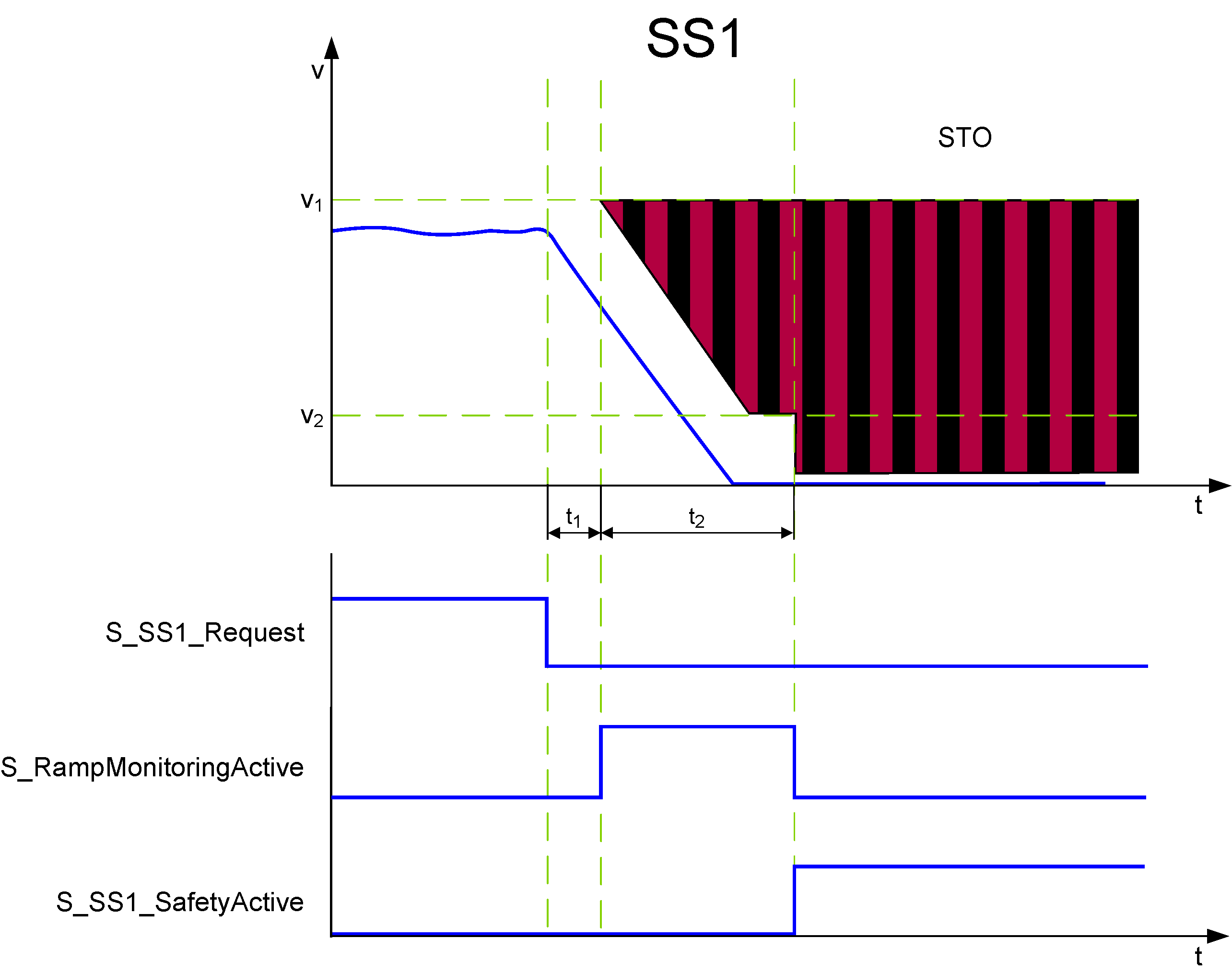The Safe Stop 1 function causes a rapid and safe stopping of a drive. It controls the drive to decelerate autonomously and finally activates the drive-internal Safe Torque Off (STO) safety-related function. As a result, the drive remains torque-free and the motor is no longer supplied with power. (In contrast, the Safe Stop 2 function finally monitors the standstill (similar to the SOS function) instead of STO.)
The active STO function results in a subsequent start-up/restart inhibit (see section below).
SS1 realizes a functional safety-related stop in accordance with stop category 1 according to EN 60204-1.
SS1 is the defined fallback function of the safety-related functions SLS1 to SLS4, SMS, SDIneg, and SDIpos.
Monitoring by the Safety-Related FB/Safety Module
The monitoring behavior by the function block depends on the parameterization of the Safety Module:
oIf ramp monitoring is deactivated, monitoring is passive until the t2 time interval has elapsed (see figure and description below).
oIf ramp monitoring is activated, the Safety Module monitors the motor deceleration rate specified by the deceleration ramp.
In both cases, the SS1 function stops the motor and then initiates the STO function to set the drive torque-free.
The request of the safety-related function occurs at the beginning of the t1 time interval (S_SS1_Request signal in the diagram on the left). t1 is set with the device parameter SS1_StartDelayTime[t1].

Within the t1 time interval, the standard (non-safety-related) controller also receives the request from the connected process and initiates the motion control function according to the logic and drive parameterization defined in the standard (non-safety-related) application.
After t1 has elapsed, the deceleration of the drive is executed. The maximum allowed duration t2 of this ramp-down phase is defined by the device parameter SS1_RampMonitoringTime[t2]. At the end of t2, STO is activated.
During t2, the deceleration can be monitored by setting the device parameter SS1_RampMonitoring = Activated.
If ramp monitoring is deactivated, the deceleration curve is not monitored. Even acceleration is allowed during the t2 interval. Standstill is enforced when t2 elapses by engaging the STO function.
If ramp monitoring is activated, the deceleration curve is monitored and must follow the parameterized ramp (as shown in the figure). Otherwise, STO is activated as the defined fallback function.
If zero speed has been achieved while t2 has not yet elapsed, a defined velocity tolerance (parameter SS1_MinRampVelocity[v2]) of the axis is allowed and monitored in respect with v2.
If the torque-free status of the drive has been achieved by the correct execution of the SS1 function, the function block switches S_SS1_SafetyActive = SAFETRUE (see diagram). Otherwise, if the STO fallback function has been activated due to an error detected as described above, this is indicated by S_STO_SafetyActive = SAFETRUE.
If the parameterized SS1_RampMonitoringTime[t2] value is exceeded, or (in case of activated ramp monitoring) if the parameterized deceleration ramp is not respected as defined, or if the velocity tolerance (v2 in the figure) is exceeded, the STO function is automatically executed as the fallback function.
The SS1 function is used if a controlled deceleration of the drive with a following torque-free standstill state is required, for example, after a safety-relevant event.
SS1 is suitable to bring a large flywheel mass as quickly as possible to a halt or to slow down and come to a standstill from high drive speeds as fast as possible. Typical examples are grinding spindles, centrifuges, storage, and retrieval devices.